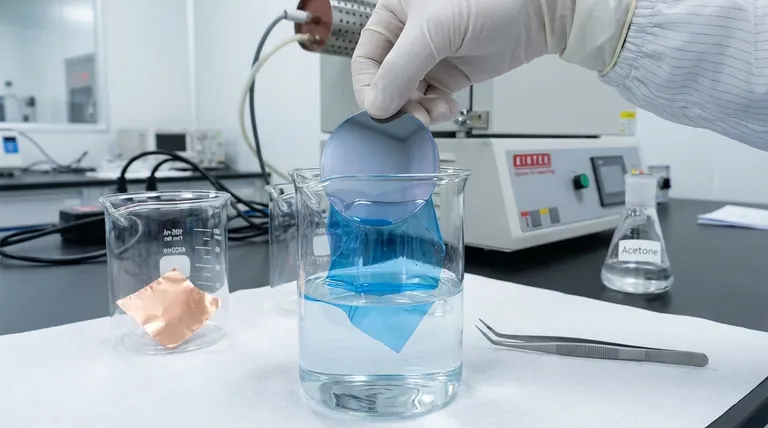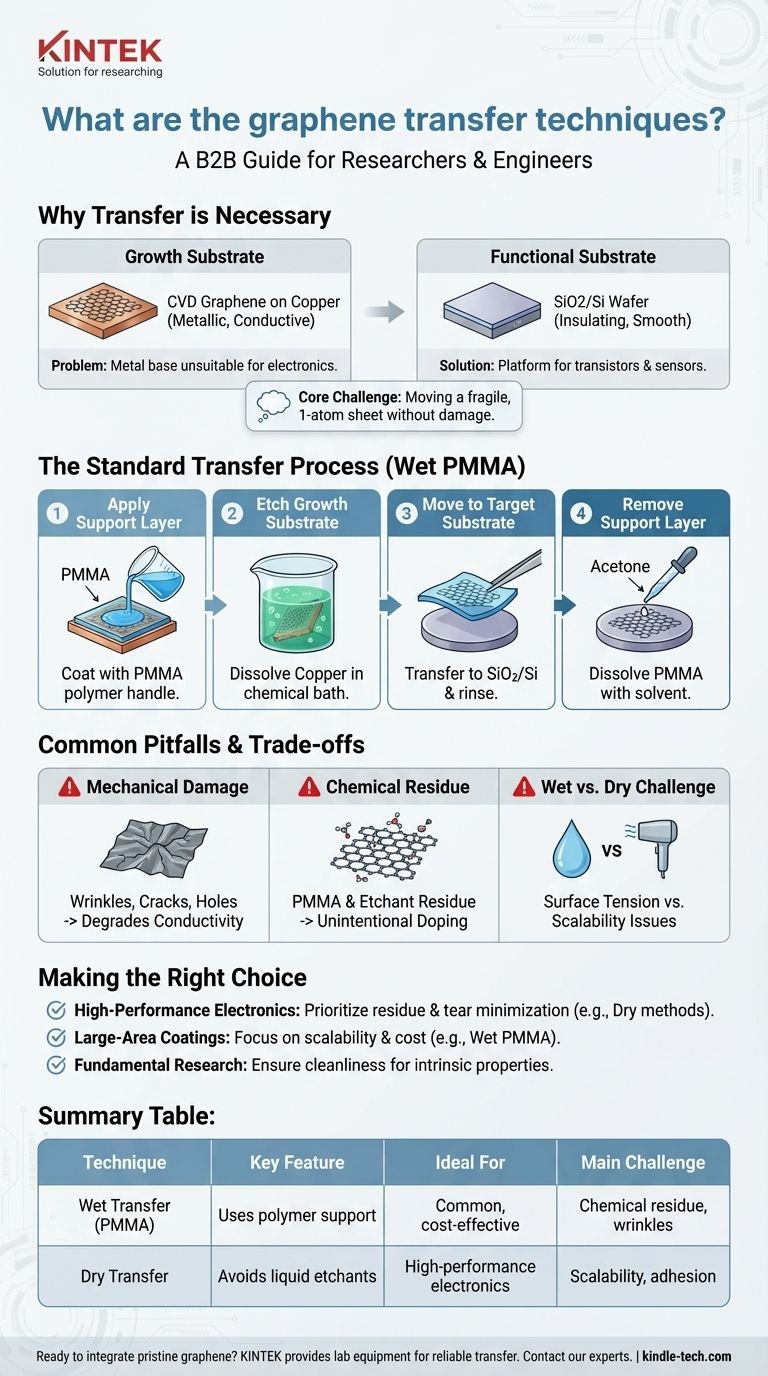转移石墨烯最常用的方法是利用聚合物支撑层(通常是PMMA)将单原子厚的薄膜从其生长基底转移到目标基底上。在用PMMA涂覆石墨烯后,原始的生长基底被化学蚀刻掉,留下漂浮的PMMA/石墨烯薄膜,然后可以小心地将其放置在新表面上,最后溶解PMMA。
石墨烯转移的核心挑战是如何在不引入皱纹、撕裂或化学污染(这些都会降低其卓越性能)的情况下,将脆弱的单原子厚薄膜从一个表面移动到另一个表面。
为什么需要石墨烯转移
生长基底的问题
石墨烯通常使用化学气相沉积(CVD)等方法合成,在此过程中,它在铜箔等金属催化剂上生长成薄膜。
虽然这些金属基底非常适合生长,但它们不适合石墨烯的最终应用,特别是在需要绝缘或半导体基底的电子领域。
转移到功能性基底上
为了制造晶体管、传感器或其他器件,必须将石墨烯转移到功能性目标基底上。
带有氧化物层的硅晶圆(SiO2/Si)是一个常见的选择,因为它具有绝缘性、非常光滑的表面,并且是整个半导体行业的标准平台。转移过程是连接石墨烯合成和其实际应用的关键桥梁。

标准转移过程的结构
最成熟的技术是使用聚合物支架来支撑石墨烯薄膜的“湿法转移”。
步骤 1:应用支撑层
将聚合物溶液,最常见的是聚甲基丙烯酸甲酯或PMMA,直接涂覆在石墨烯薄膜上,此时石墨烯仍在其原始生长基底上。
该PMMA层充当临时手柄和机械支撑,防止超薄石墨烯在后续步骤中折叠、撕裂或解体。
步骤 2:蚀刻生长基底
将整个样品(PMMA/石墨烯/铜)放入化学浴或蚀刻剂中,选择性地溶解原始的生长基底。
对于铜基底,使用三氯化铁或过硫酸铵等蚀刻剂。此过程使PMMA/石墨烯薄膜漂浮在液体表面上。
步骤 3:转移到目标基底上
小心地将漂浮的薄膜从蚀刻溶液中“捞出”,通常是通过将目标SiO2/Si基底置于其下方并缓慢将其提起。然后将薄膜在去离子水中冲洗,以去除残留的蚀刻剂,然后小心地铺展到新基底上。
步骤 4:去除支撑层
一旦薄膜牢固地定位在目标基底上,最后一步是去除PMMA支撑层。
这通常是通过使用丙酮等溶剂溶解PMMA来完成的,随后进行最终冲洗。如果成功,新基底上将只留下干净的单层石墨烯。
常见的陷阱和权衡
完美的转移是理想的,但现实情况涉及重大的挑战,这些挑战可能会影响最终石墨烯薄膜的质量。
机械损伤问题
处理原子厚的薄片非常困难。皱纹、裂纹和孔洞是在转移过程中引入的常见缺陷。
这些缺陷会破坏石墨烯连续的蜂窝状晶格,从而降低其导电性和机械强度。
化学残留物问题
过程中使用的化学物质——即PMMA和蚀刻剂——可能会留下残留物和污染。
即使是微量的聚合物或金属离子也可能无意中“掺杂”石墨烯,从而改变其电子特性并阻碍器件性能。
湿法与干法的挑战
上述标准的“湿法”转移过程引入了来自液体的表面张力,这可能导致起皱并需要小心干燥。
这促使人们开发了替代的“干法”转移方法,尽管它们在可扩展性和薄膜附着力方面通常有其自身的权衡。湿法PMMA方法因其相对简单和低成本而仍然是最常见的方法。
为您的目标做出正确的选择
转移过程中可接受的缺陷水平完全取决于预期应用。
- 如果您的主要重点是高性能电子设备: 优先事项必须是最大限度地减少化学残留物和机械撕裂的转移过程,因为这些会直接影响载流子迁移率和器件可靠性。
- 如果您的主要重点是大面积涂层或复合材料: 可扩展性、成本以及在较大面积上保持薄膜连续性比实现完美无瑕的单层更重要。
- 如果您的主要重点是基础研究: 转移的清洁度和基底的选择对于确保实验测量反映石墨烯的固有特性,而不是过程产生的伪影至关重要。
最终,掌握石墨烯的转移与掌握其生长一样重要,是释放其真正潜力的关键。
摘要表:
| 技术 | 关键特征 | 理想用途 | 主要挑战 |
|---|---|---|---|
| 湿法转移 (PMMA) | 使用聚合物支撑层 | 常用方法,经济高效 | 化学残留物,皱纹 |
| 干法转移 | 避免使用液体蚀刻剂 | 高性能电子设备 | 可扩展性,附着力 |
准备将纯净的石墨烯集成到您的设备中了吗? 正确的转移技术对性能至关重要。KINTEK 专注于提供可靠的石墨烯转移所需的实验室设备和耗材,服务于研发实验室。 立即联系我们的专家,讨论我们如何支持您的特定应用需求并确保高质量的结果。
图解指南




















